Zeyue Tian
AudioX: Diffusion Transformer for Anything-to-Audio Generation
Mar 13, 2025Abstract:Audio and music generation have emerged as crucial tasks in many applications, yet existing approaches face significant limitations: they operate in isolation without unified capabilities across modalities, suffer from scarce high-quality, multi-modal training data, and struggle to effectively integrate diverse inputs. In this work, we propose AudioX, a unified Diffusion Transformer model for Anything-to-Audio and Music Generation. Unlike previous domain-specific models, AudioX can generate both general audio and music with high quality, while offering flexible natural language control and seamless processing of various modalities including text, video, image, music, and audio. Its key innovation is a multi-modal masked training strategy that masks inputs across modalities and forces the model to learn from masked inputs, yielding robust and unified cross-modal representations. To address data scarcity, we curate two comprehensive datasets: vggsound-caps with 190K audio captions based on the VGGSound dataset, and V2M-caps with 6 million music captions derived from the V2M dataset. Extensive experiments demonstrate that AudioX not only matches or outperforms state-of-the-art specialized models, but also offers remarkable versatility in handling diverse input modalities and generation tasks within a unified architecture. The code and datasets will be available at https://zeyuet.github.io/AudioX/
YuE: Scaling Open Foundation Models for Long-Form Music Generation
Mar 11, 2025Abstract:We tackle the task of long-form music generation--particularly the challenging \textbf{lyrics-to-song} problem--by introducing YuE, a family of open foundation models based on the LLaMA2 architecture. Specifically, YuE scales to trillions of tokens and generates up to five minutes of music while maintaining lyrical alignment, coherent musical structure, and engaging vocal melodies with appropriate accompaniment. It achieves this through (1) track-decoupled next-token prediction to overcome dense mixture signals, (2) structural progressive conditioning for long-context lyrical alignment, and (3) a multitask, multiphase pre-training recipe to converge and generalize. In addition, we redesign the in-context learning technique for music generation, enabling versatile style transfer (e.g., converting Japanese city pop into an English rap while preserving the original accompaniment) and bidirectional generation. Through extensive evaluation, we demonstrate that YuE matches or even surpasses some of the proprietary systems in musicality and vocal agility. In addition, fine-tuning YuE enables additional controls and enhanced support for tail languages. Furthermore, beyond generation, we show that YuE's learned representations can perform well on music understanding tasks, where the results of YuE match or exceed state-of-the-art methods on the MARBLE benchmark. Keywords: lyrics2song, song generation, long-form, foundation model, music generation
Audio-FLAN: A Preliminary Release
Feb 23, 2025Abstract:Recent advancements in audio tokenization have significantly enhanced the integration of audio capabilities into large language models (LLMs). However, audio understanding and generation are often treated as distinct tasks, hindering the development of truly unified audio-language models. While instruction tuning has demonstrated remarkable success in improving generalization and zero-shot learning across text and vision, its application to audio remains largely unexplored. A major obstacle is the lack of comprehensive datasets that unify audio understanding and generation. To address this, we introduce Audio-FLAN, a large-scale instruction-tuning dataset covering 80 diverse tasks across speech, music, and sound domains, with over 100 million instances. Audio-FLAN lays the foundation for unified audio-language models that can seamlessly handle both understanding (e.g., transcription, comprehension) and generation (e.g., speech, music, sound) tasks across a wide range of audio domains in a zero-shot manner. The Audio-FLAN dataset is available on HuggingFace and GitHub and will be continuously updated.
Foundation Models for Music: A Survey
Aug 27, 2024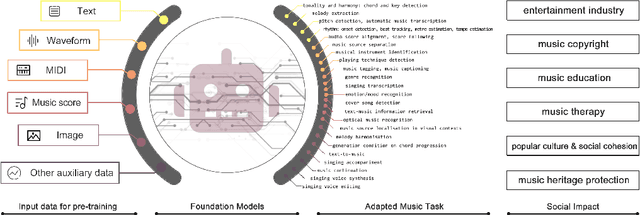
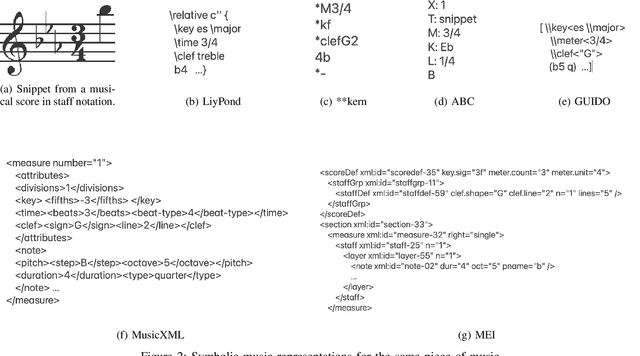
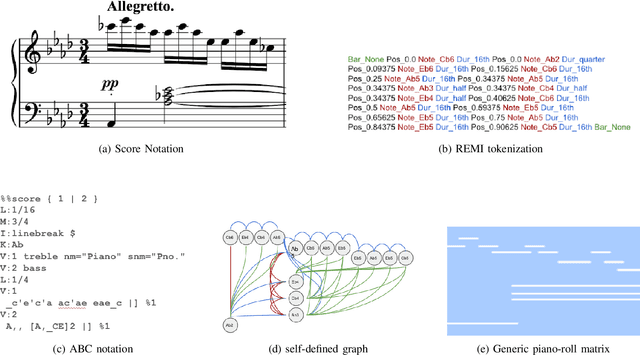
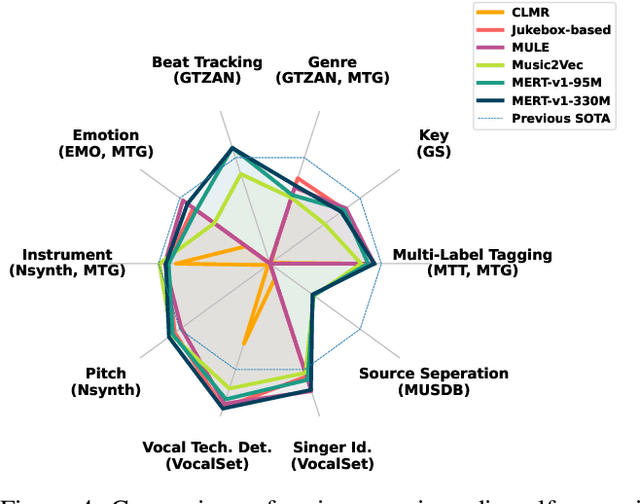
Abstract:In recent years, foundation models (FMs) such as large language models (LLMs) and latent diffusion models (LDMs) have profoundly impacted diverse sectors, including music. This comprehensive review examines state-of-the-art (SOTA) pre-trained models and foundation models in music, spanning from representation learning, generative learning and multimodal learning. We first contextualise the significance of music in various industries and trace the evolution of AI in music. By delineating the modalities targeted by foundation models, we discover many of the music representations are underexplored in FM development. Then, emphasis is placed on the lack of versatility of previous methods on diverse music applications, along with the potential of FMs in music understanding, generation and medical application. By comprehensively exploring the details of the model pre-training paradigm, architectural choices, tokenisation, finetuning methodologies and controllability, we emphasise the important topics that should have been well explored, like instruction tuning and in-context learning, scaling law and emergent ability, as well as long-sequence modelling etc. A dedicated section presents insights into music agents, accompanied by a thorough analysis of datasets and evaluations essential for pre-training and downstream tasks. Finally, by underscoring the vital importance of ethical considerations, we advocate that following research on FM for music should focus more on such issues as interpretability, transparency, human responsibility, and copyright issues. The paper offers insights into future challenges and trends on FMs for music, aiming to shape the trajectory of human-AI collaboration in the music realm.
MMTrail: A Multimodal Trailer Video Dataset with Language and Music Descriptions
Jul 30, 2024



Abstract:Massive multi-modality datasets play a significant role in facilitating the success of large video-language models. However, current video-language datasets primarily provide text descriptions for visual frames, considering audio to be weakly related information. They usually overlook exploring the potential of inherent audio-visual correlation, leading to monotonous annotation within each modality instead of comprehensive and precise descriptions. Such ignorance results in the difficulty of multiple cross-modality studies. To fulfill this gap, we present MMTrail, a large-scale multi-modality video-language dataset incorporating more than 20M trailer clips with visual captions, and 2M high-quality clips with multimodal captions. Trailers preview full-length video works and integrate context, visual frames, and background music. In particular, the trailer has two main advantages: (1) the topics are diverse, and the content characters are of various types, e.g., film, news, and gaming. (2) the corresponding background music is custom-designed, making it more coherent with the visual context. Upon these insights, we propose a systemic captioning framework, achieving various modality annotations with more than 27.1k hours of trailer videos. Here, to ensure the caption retains music perspective while preserving the authority of visual context, we leverage the advanced LLM to merge all annotations adaptively. In this fashion, our MMtrail dataset potentially paves the path for fine-grained large multimodal-language model training. In experiments, we provide evaluation metrics and benchmark results on our dataset, demonstrating the high quality of our annotation and its effectiveness for model training.
VidMuse: A Simple Video-to-Music Generation Framework with Long-Short-Term Modeling
Jun 06, 2024Abstract:In this work, we systematically study music generation conditioned solely on the video. First, we present a large-scale dataset comprising 190K video-music pairs, including various genres such as movie trailers, advertisements, and documentaries. Furthermore, we propose VidMuse, a simple framework for generating music aligned with video inputs. VidMuse stands out by producing high-fidelity music that is both acoustically and semantically aligned with the video. By incorporating local and global visual cues, VidMuse enables the creation of musically coherent audio tracks that consistently match the video content through Long-Short-Term modeling. Through extensive experiments, VidMuse outperforms existing models in terms of audio quality, diversity, and audio-visual alignment. The code and datasets will be available at https://github.com/ZeyueT/VidMuse/.
LLMs Meet Multimodal Generation and Editing: A Survey
May 29, 2024Abstract:With the recent advancement in large language models (LLMs), there is a growing interest in combining LLMs with multimodal learning. Previous surveys of multimodal large language models (MLLMs) mainly focus on understanding. This survey elaborates on multimodal generation across different domains, including image, video, 3D, and audio, where we highlight the notable advancements with milestone works in these fields. Specifically, we exhaustively investigate the key technical components behind methods and multimodal datasets utilized in these studies. Moreover, we dig into tool-augmented multimodal agents that can use existing generative models for human-computer interaction. Lastly, we also comprehensively discuss the advancement in AI safety and investigate emerging applications as well as future prospects. Our work provides a systematic and insightful overview of multimodal generation, which is expected to advance the development of Artificial Intelligence for Generative Content (AIGC) and world models. A curated list of all related papers can be found at https://github.com/YingqingHe/Awesome-LLMs-meet-Multimodal-Generation
ComposerX: Multi-Agent Symbolic Music Composition with LLMs
Apr 30, 2024



Abstract:Music composition represents the creative side of humanity, and itself is a complex task that requires abilities to understand and generate information with long dependency and harmony constraints. While demonstrating impressive capabilities in STEM subjects, current LLMs easily fail in this task, generating ill-written music even when equipped with modern techniques like In-Context-Learning and Chain-of-Thoughts. To further explore and enhance LLMs' potential in music composition by leveraging their reasoning ability and the large knowledge base in music history and theory, we propose ComposerX, an agent-based symbolic music generation framework. We find that applying a multi-agent approach significantly improves the music composition quality of GPT-4. The results demonstrate that ComposerX is capable of producing coherent polyphonic music compositions with captivating melodies, while adhering to user instructions.
Seeing and Hearing: Open-domain Visual-Audio Generation with Diffusion Latent Aligners
Feb 27, 2024



Abstract:Video and audio content creation serves as the core technique for the movie industry and professional users. Recently, existing diffusion-based methods tackle video and audio generation separately, which hinders the technique transfer from academia to industry. In this work, we aim at filling the gap, with a carefully designed optimization-based framework for cross-visual-audio and joint-visual-audio generation. We observe the powerful generation ability of off-the-shelf video or audio generation models. Thus, instead of training the giant models from scratch, we propose to bridge the existing strong models with a shared latent representation space. Specifically, we propose a multimodality latent aligner with the pre-trained ImageBind model. Our latent aligner shares a similar core as the classifier guidance that guides the diffusion denoising process during inference time. Through carefully designed optimization strategy and loss functions, we show the superior performance of our method on joint video-audio generation, visual-steered audio generation, and audio-steered visual generation tasks. The project website can be found at https://yzxing87.github.io/Seeing-and-Hearing/
ChatMusician: Understanding and Generating Music Intrinsically with LLM
Feb 25, 2024
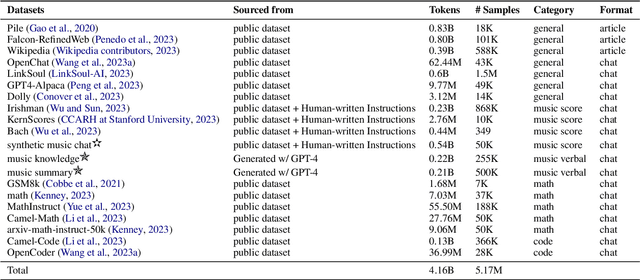


Abstract:While Large Language Models (LLMs) demonstrate impressive capabilities in text generation, we find that their ability has yet to be generalized to music, humanity's creative language. We introduce ChatMusician, an open-source LLM that integrates intrinsic musical abilities. It is based on continual pre-training and finetuning LLaMA2 on a text-compatible music representation, ABC notation, and the music is treated as a second language. ChatMusician can understand and generate music with a pure text tokenizer without any external multi-modal neural structures or tokenizers. Interestingly, endowing musical abilities does not harm language abilities, even achieving a slightly higher MMLU score. Our model is capable of composing well-structured, full-length music, conditioned on texts, chords, melodies, motifs, musical forms, etc, surpassing GPT-4 baseline. On our meticulously curated college-level music understanding benchmark, MusicTheoryBench, ChatMusician surpasses LLaMA2 and GPT-3.5 on zero-shot setting by a noticeable margin. Our work reveals that LLMs can be an excellent compressor for music, but there remains significant territory to be conquered. We release our 4B token music-language corpora MusicPile, the collected MusicTheoryBench, code, model and demo in GitHub.
 Add to Chrome
Add to Chrome Add to Firefox
Add to Firefox Add to Edge
Add to Edge